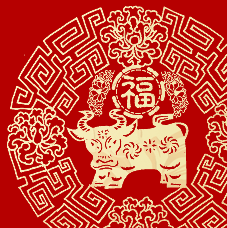Whipping the Spring Ox
The Beginning of Spring (Li Chun in Chinese), as the name indicates, marks the start of a new spring, and usually falls on the 4th or 5th of February, when many customs are observed among Chinese people. One of them is “whipping the Spring Ox.”
As recorded in "A General History of Chenghai County" of the Qing Dynasty (1644-1911), when the first day of spring came, the government, with a group of people, would go to the suburbs for a spring celebration. Usually, a ceremony was held, after which people would whip the ox, known as "Da Chun Niu" in Chinese.
This tradition dates back to as early as the Zhou Dynasty (11th century-771BC). Prior to the Beginning of Spring every year, the government would prepare a clay image of the god of grain as well as a clay ox.
When the day came, government officials, followed by large crowds, would go to the Grain God Pavilion and the Clay Ox Platform previously placed in the suburb's eastern part. One person of the celebrating team, dressed in black, would drive a black wagon with a black flag on it, while others would blow trumpets, sing songs, dance or wave flags.
Upon arrival, a sacrificial ceremony was held before the whipping of the clay ox. By the time of Ming (1368-1644) and Qing dynasties, celebrations had become even grander.
The custom of whipping the spring ox was meant to encourage farming. Even today, the custom, which is closely related to agriculture, remains in Chaozou and Shantou of South China's Guangdong Province, since the soil in those areas is fertile and productive. However, some of the details have been changed; for example, people might not whip a clay ox anymore.
Ox King Festival of Gelao people
Ox King Festival is annually observed by Gelao ethnic group in Guizhou, Southwest China. It is the special festival of the Gelao people, and falls on October 1 of the lunar calendar. On the occasion, the local people will slay chooks and prepare wine to worship the Ox King for good health of farm cattle. Every family, which raises the cattle will free their livestock from farming one day, and feed the cattle with their best feedstuff. In addition, two Baba cakes made from sticky rice will be hung on the two horns of the cattle. They pull the cattle to the riverbank and let it look in the mirror, trying to make it happy, and then they take the cakes down to feed the cattle.
Bullfighting Festival of Miao people
The Miao are one of the most ancient of China's nationalities, tracing their origins back more than 4,000 years. Miao people consider the bull a symbol of health, power, hard work and bravery, and the bullfighting festival epitomizes their inordinate fondness for bulls.
This festival is observed by the Miao people in the Kaiyang County of Yunnan province on the 25th day of the first lunar month. Legend has it that Kaiyang County once suffered a disastrous flood that wreaked havoc for a long time. On the 25th day of the first lunar month, when two bulls fought with each other beside the inundated riverbank, the flood miraculously subsided. Following they had a bumper harvest, an occurrence that seemed to confirm the auspicious events that preceded it. This is the origin of the festival. Miao people hold bullfighting festivals on that date every year to show their gratitude toward the bull.



